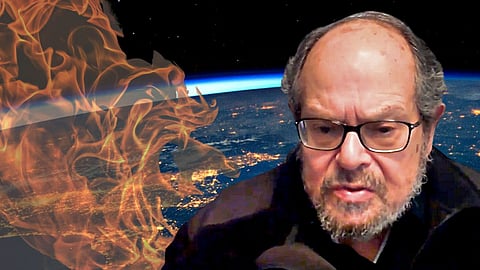Dr Richard Lindzen exposes the climate change movement as a fabricated, politicised power play motivated by malice and profit.
Veteran climate expert Dr Richard Lindzen made a name for himself before the term "climate scientist" had even been invented. In an interview with the pioneering atmospheric physicist and former emeritus professor of meteorology at MIT, he recounted how, between 1989 and 1996, funding for climate science in the US increased by a factor of 15, giving birth to the field of climate science and its absurdly stretched list of climate impacts. Having begun his research on climate change in the mid-70s motivated by a sincere interest in understanding the Earth's climate regimes, Lindzen's assessment of the various elements paraded as scientific evidence of an impending climate catastrophe is remarkably sensible, revealing the complicity of the media and politicians in forcing the disastrous climate change narrative upon an unsuspecting and trusting public from the very beginning. – Nadya Swart
- 00:00 Dr Richard Lindzen on his career as an atmospheric physicist and what drew him to study Earth's climate
- 01:21 On carbon dioxide and the greenhouse effect
- 05:02 On politicians, the United Nations, the Intergovernmental Panel on Climate Change and the enabling of climate hysteria
- 07:21 On the politicisation of climate change and the significant human progress enabled by the fossil fuel industry
- 08:45 On the environmental destruction caused by renewable energy sources
- 09:46 On the cult-like climate activism movement and its demonisation of carbon dioxide
- 12:41 On the purported scientific consensus on climate change
- 14:46 On the Clinton-Gore administration's funding of climate impacts between 1989 and 1996
- 17:35 On Professor Guy McPherson's claim that abrupt climate change will lead to human extinction by 2026
- 18:22 On the motives behind the climate change/green energy movement
- 19:23 On his iris hypothesis on climate change proposed in 2001
- 21:56 On the epistemological issues relating to climate change
- 23:59 On climate variability vs anthropogenic climate change
- 27:19 On his experience with institutional bias in favour of scientists who support the official climate change narrative and the influence of institutional funding scientific research
- 29:50 How the situation is rigged to support the narrative and the complicity of politicians and scientists
- 32:10 On the climate catastrophe prediction and how this compares to reality
Excerpts from the interview with Dr Richard Lindzen
Dr Richard Lindzen on the significance of climate variability compared to anthropogenic climate change
We do know that climate, long before there were even people, was changing pronouncedly. Even before the Industrial Revolution, there was a little ice age. They had all sorts of documents, you know, villages in the Alps, saying, "The ice is overtaking our village." You had ice ages every 100,000 years, in which you had massive glaciation. And, you know, these had nothing to do with people. You would need to understand those. And there was progress.
During the Ice Ages, a man called Milankovitch noticed that they bore a relationship to orbital variations. And this took a while, but there was a climate program trying to find out how this worked. And we have a pretty good idea at this point of why that worked, and Milankovitch was pretty much right. We said, "We depend very much on solar radiation in summer at high latitudes." And that was a well-known feature of glaciology; that whether a glacier grows or not doesn't depend so much on winter. Winters are always cold in the northern hemisphere. But in summer, if the snow that accumulated in winter melts, you don't build a glacier. If the summer is cool and the glaciers' snow doesn't fully melt, you build each year, [you have] thousands of years to build up your glacier.
Well, it turns out that CO2 follows temperature and the ice ages, and it changes enough to change the flux by about a watt per meter squared. If, on the other hand, you look at the Milankovitch parameter, how much does the incoming solar radiation vary over the course of this Ice Age cycle? It's 100 watts per square meter. That's much more significant.
On the media's fabrication of "scientific consensus" on climate change
In 1988, when Jim Hansen first testified before the US Senate, Newsweek ran a cover issue on it, showing the Earth on fire with the claim beneath it, "All scientists agree." No scientists were asked. This was the way you convinced the public. The public is pretty illiterate when it comes to science. And I think what is often ignored is I don't think the public feels comfortable about that. So you immediately assure them the scientists all agree, you don't have to worry about it. And they do that whether the scientists agree or not.
On the environmental movement doing immense harm
It's almost as though the environmental movement has decided to commit suicide. And go in for things that destroy the environment, which is what you're doing with solar panels, windmills, etc. You're killing birds. You're destroying the environment. These have lifetimes of 10/20 years, and you don't know how to dispose of them. This has nothing to do with the environment. It's a power play.
It's an evil movement, and it's causing immense damage. It is trying to condemn people in Africa, in the developing world, to perpetual poverty. And you have to ask, why would this be a goal? I don't know.
Read Also:
- Neither an energy transition nor climate crisis exists – Alex Epstein builds the moral case for fossil fuels
- "Data shows there's no climate catastrophe looming" – climatologist Dr John Christy debunks the climate crisis narrative
- Elimination of CO2 is a suicide pact – Professor William Happer on climate change misconceptions and hysteria

